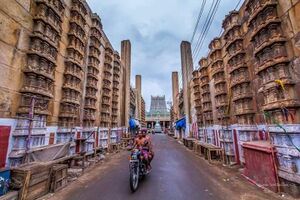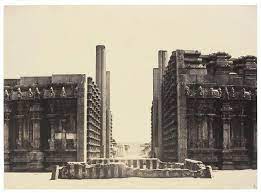Raya Gopuram (Madurai): Difference between revisions
No edit summary |
(Made changes as per Tamil entry) |
||
| Line 1: | Line 1: | ||
{{Read Tamil|Name of target page=இராய கோபுரம் (மதுரை)|Title of target page=இராய கோபுரம் (மதுரை)}}[[File:Incomplete Raj Tower Madurai.jpg|thumb|Raya Gopuram- First Floor]]Raya Gopuram (1654-1659) was built by Thirumalai Nayakar in the Avani Moola street, outside the Meenakshi Amman temple. The first floor of this ''gopuram'' (tower) is 18 meters high. The first floor is twice as big as the other ''gopuram'' inside the temple. This would’ve been the biggest ''gopuram'' in the south of India if the construction had been completed. It is situated on the ''Ezhu Kadal'' street on the eastern side of the Meenakshi Amman temple. | {{Read Tamil|Name of target page=இராய கோபுரம் (மதுரை)|Title of target page=இராய கோபுரம் (மதுரை)}}[[File:Incomplete Raj Tower Madurai.jpg|thumb|Raya Gopuram- First Floor]]Raya Gopuram Madurai (1654-1659) was built by Thirumalai Nayakar in the Avani Moola street, outside the Meenakshi Amman temple. The first floor of this ''gopuram'' (tower) is 18 meters high. The first floor is twice as big as the other ''gopuram'' inside the temple. This would’ve been the biggest ''gopuram'' in the south of India if the construction had been completed. It is situated on the ''Ezhu Kadal'' street on the eastern side of the Meenakshi Amman temple. | ||
== | |||
Raya Gopuram Madurai (1654-1659) is a foundation of an unfinished gopuram (tower) near the Madurai Meenakshi Amman temple. The construction of Raya Goguram was started by Thirumalai Nayakkar, ruler of Madurai. The gopuram is situated outside the Madurai Meenakshi Amman temple in the aavani moola street. First floor of this gopuram is 18 meters high and it is twice the size of first floors of other gopurams in the Madurai temple complex. Raya Gopuram would have been the biggest gopuram in South India had its construction been completed. It is located in the eastern end of Meenakshi Amman temple at the beginning of yelukadal veedhi (seven seas street). | |||
== Etymology == | |||
The word 'Raya' means stone in Telugu language. Since the gopuram is made of stone or rocks, it is called Raya Gopuram. Thirumalai Nayakkar was also called as 'Rayar'. It could also mean that the gopuram belonged to him. | |||
== பதிவுகள் == | |||
Photographer Linnaeus Tripe's book ''Photographic Views in Madurai'' (Madras, 1858) contains the now available oldest picture of Madurai's unfinished gopuram. This picture was taken in 1858. | |||
== History == | |||
Thirumalai Nayakar completed the construction of the new ''mandapam'' (hall) inside the Meenakshi Amman temple in 1654. Subsequently, he started constructing the Raya Gopuram in the Avani Moola street. The new mandapam and the Raya Gopuram were constructed as part of the Madurai Meenakshi Amman temple complex. | |||
It is said that, Thirumalai Nayakkar desired to construct similar gopurams in the 64 saiva, vainava (Shiva, Vishnu) temples. These temples were located in Uttathur to Kanyakumari, under the control of Madurai Nayakkar government. Though it is said that foundations for many temples were laid during this time and completed by the later rulers, no strong evidence is available. | |||
== Construction == | |||
Thirumalai Nayakar started constructing the ''gopuram'' in the year 1654; after completing the ''mandapam.'' The construction was suspended the year he died—in 1659. | Thirumalai Nayakar started constructing the ''gopuram'' in the year 1654; after completing the ''mandapam.'' The construction was suspended the year he died—in 1659. | ||
The construction of | Thiruvannamalai Rajagopuram, 217 feet high was the tallest gopuram in Tamil Nadu when Madurai Raya Gopuram's construction began. Thirumalai Nayakkar aspired Raya Gopuram to be taller than the former. The height of Madurai Raya Gopuram's ''Kalhaara'' (foundation) was 50 feet. Kalhaara is 170 feet long and 110 feet wide. Experts of tower craft speculate Madurai Raya Gopuram's height as 300 feet, had it been completed. Thirumalai Nayakkar began the construction of Raya Gopuram in the year 1654. Due to his illness at the old age of 70 and the economic crisis in Madurai, after his death in 1659 the construction of the Raya Gopuram was suspended. | ||
== Current State == | |||
Madurai Raya Gopuram remains abandoned for a very a long time. Merchants have used bamboos and nails to build shops out of it. Buildings have also been constructed along the foundation of the gopuram. The Raya Gopuram is inaccessible as it has become a congested commercial area. | |||
The | |||
== About == | == About == | ||
J. P. L. Shenoy I. C. S., the commissionership of | J. P. L. Shenoy I. C. S., the commissionership of Madurai said, “This would’ve been one of the greatest buildings in India if it had been completed” in his book “Kovil Nagaram Madurai”. | ||
== Nearby Archeological Sites == | |||
Sites like Patthu Thun, Thirumalai Nayakkar Mahal are present near the Raya Gopuram. [[File:இராய கோபுரம்.jpg|thumb|Raya Gopuram]] | |||
== Reference == | == Reference == | ||
* Madurai Nayakar's history. | * Madurai Nayakar's history, [[A. K. Paranthamanar]] | ||
== Links == | == Links == | ||
* [http://www.tamilvu.org/slet/lA100/lA100pd1.jsp?bookid=222&pno=252 Tamil Virtual University] | * [http://www.tamilvu.org/slet/lA100/lA100pd1.jsp?bookid=222&pno=252 Tamil Virtual University] | ||
* [https://www.vikatan.com/spiritual/temples/know-the-history-and-the-story-behind-madurai-temple-raya-gopuram Madurai Raya Gopuram- Vikatan article.] | * [https://www.vikatan.com/spiritual/temples/know-the-history-and-the-story-behind-madurai-temple-raya-gopuram Madurai Raya Gopuram- Vikatan article.] | ||
{{Ready for review-en}} | {{Ready for review-en}} | ||
Revision as of 12:13, 16 June 2022
இந்தப் பக்கத்தை தமிழில் வாசிக்க: இராய கோபுரம் (மதுரை)
Raya Gopuram Madurai (1654-1659) was built by Thirumalai Nayakar in the Avani Moola street, outside the Meenakshi Amman temple. The first floor of this gopuram (tower) is 18 meters high. The first floor is twice as big as the other gopuram inside the temple. This would’ve been the biggest gopuram in the south of India if the construction had been completed. It is situated on the Ezhu Kadal street on the eastern side of the Meenakshi Amman temple.
Raya Gopuram Madurai (1654-1659) is a foundation of an unfinished gopuram (tower) near the Madurai Meenakshi Amman temple. The construction of Raya Goguram was started by Thirumalai Nayakkar, ruler of Madurai. The gopuram is situated outside the Madurai Meenakshi Amman temple in the aavani moola street. First floor of this gopuram is 18 meters high and it is twice the size of first floors of other gopurams in the Madurai temple complex. Raya Gopuram would have been the biggest gopuram in South India had its construction been completed. It is located in the eastern end of Meenakshi Amman temple at the beginning of yelukadal veedhi (seven seas street).
Etymology
The word 'Raya' means stone in Telugu language. Since the gopuram is made of stone or rocks, it is called Raya Gopuram. Thirumalai Nayakkar was also called as 'Rayar'. It could also mean that the gopuram belonged to him.
பதிவுகள்
Photographer Linnaeus Tripe's book Photographic Views in Madurai (Madras, 1858) contains the now available oldest picture of Madurai's unfinished gopuram. This picture was taken in 1858.
History
Thirumalai Nayakar completed the construction of the new mandapam (hall) inside the Meenakshi Amman temple in 1654. Subsequently, he started constructing the Raya Gopuram in the Avani Moola street. The new mandapam and the Raya Gopuram were constructed as part of the Madurai Meenakshi Amman temple complex.
It is said that, Thirumalai Nayakkar desired to construct similar gopurams in the 64 saiva, vainava (Shiva, Vishnu) temples. These temples were located in Uttathur to Kanyakumari, under the control of Madurai Nayakkar government. Though it is said that foundations for many temples were laid during this time and completed by the later rulers, no strong evidence is available.
Construction
Thirumalai Nayakar started constructing the gopuram in the year 1654; after completing the mandapam. The construction was suspended the year he died—in 1659.
Thiruvannamalai Rajagopuram, 217 feet high was the tallest gopuram in Tamil Nadu when Madurai Raya Gopuram's construction began. Thirumalai Nayakkar aspired Raya Gopuram to be taller than the former. The height of Madurai Raya Gopuram's Kalhaara (foundation) was 50 feet. Kalhaara is 170 feet long and 110 feet wide. Experts of tower craft speculate Madurai Raya Gopuram's height as 300 feet, had it been completed. Thirumalai Nayakkar began the construction of Raya Gopuram in the year 1654. Due to his illness at the old age of 70 and the economic crisis in Madurai, after his death in 1659 the construction of the Raya Gopuram was suspended.
Current State
Madurai Raya Gopuram remains abandoned for a very a long time. Merchants have used bamboos and nails to build shops out of it. Buildings have also been constructed along the foundation of the gopuram. The Raya Gopuram is inaccessible as it has become a congested commercial area.
About
J. P. L. Shenoy I. C. S., the commissionership of Madurai said, “This would’ve been one of the greatest buildings in India if it had been completed” in his book “Kovil Nagaram Madurai”.
Nearby Archeological Sites
Sites like Patthu Thun, Thirumalai Nayakkar Mahal are present near the Raya Gopuram.
Reference
- Madurai Nayakar's history, A. K. Paranthamanar
Links
Ready for review en
Please do not write any content below this line. This section is only for editing templates & categories.


